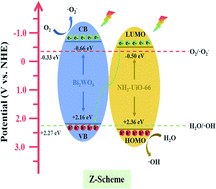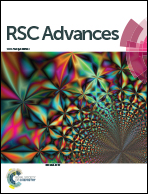A direct Z-scheme Bi2WO6/NH2-UiO-66 nanocomposite as an efficient visible-light-driven photocatalyst for NO removal†
Abstract
To explore an efficient photocatalyst for NO pollution, a direct Z-scheme photocatalytic system is successfully fabricated by coupling Bi2WO6 with NH2-UiO-66 via a simple hydrothermal synthesis technique. The Z-scheme system promotes the NO photocatalytic oxidation activity with an optimum NO removal rate of 79%, which is 2.7 and 1.2 times that obtained by using only pristine Bi2WO6 and NH2-UiO-66, respectively. Simultaneously, superior selectivity for converting NO to NO3−/NO2− is observed. The enhanced photocatalytic performance of the Bi2WO6/NH2-UiO-66 hybrids is attributed to the following two aspects: (i) large specific area of NH2-UiO-66, which exposes more active sites and is beneficial to the adsorption and activation of NO; (ii) outstanding Z-scheme structure constructed between BiWO6 and NH2-UiO-66, which can improve the efficiency of the separation of electron–hole pairs and preserves the strong oxidation ability of hybrids. ESR analysis shows that ·O2− and ·OH contribute to NO removal. A possible photocatalytic mechanism of NO oxidation on the direct Z-scheme photocatalyst (BWO/2NU) under visible light irradiation is proposed. This work displays the BWO/2NU hybrid's potential for treating low-concentration air pollutants, and the proposed Z-scheme photocatalyst design and promotion mechanism may inspire more rational synthesis of highly efficient photocatalysts for NO removal.

- This article is part of the themed collection: Adsorption and degradation of pollutants


 Please wait while we load your content...
Please wait while we load your content...